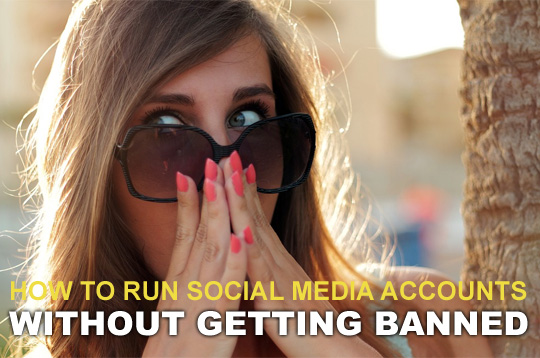Social media has become one of the most essential tools when it comes to promoting businesses. It has become so popular, in fact, that many businesses have now had to hire a social media manager just to run their social media accounts. This is a full-time job that requires knowing the ins and outs of social media, and how to best use them to your advantage.
One thing that you don’t want to do when you’re running social media accounts is get banned. Over the past few months, social media sites have begun cracking down harder on their users and banning people more easily. They are doing so in an attempt to clean up their sites, and remove accounts that aren’t following their terms of service.
Luckily, it is pretty easy to remain in their good graces and keep your account active. You just need to know what things aren’t allowed and avoid doing them.
Avoid Posting Copyrighted Material
One of the first things you can do is avoid posting anything that isn’t yours. Too many accounts have tried to pass off content as their own when it doesn’t belong to them. Then, the original owner finds out, submits a copyright infringement claim, and your account gets dinged. This means that you need to own whatever you post or provide a link to the source.
For example, it’s not against copyright to post a link to a YouTube video. However, if you download that video off of YouTube, post it on your site, and share it as if it was your own, that is copyright infringement. The same goes for things like blog articles, images, music, and infographics. If you didn’t create it, be sure to credit the author, or you risk getting banned from that social media site.
You should also know that even if something is listed under Fair Use, you can still get in trouble depending on how you use it. This video helps to explain some of the ways to properly use something under Fair Use.
Don’t Pretend to be Anyone Else
Just like you can’t post someone else’s work as your own, you also can’t pretend to be someone else. Many people try to create fake accounts for well-known people, and then use that person’s celebrity to attract followers. They then use their now popular social media account to promote something. However, impersonating someone else online is against all social media sites’ terms of service, and sooner or later you’ll get caught.
Impersonating someone else has become a real problem on social media. Law enforcement typically can’t do anything about it, and the social media sites are not always responsive. So while you might get away with creating a fake account for a little while, it’s a good idea to ask yourself if this is the route you really want to go down. Not only is using fake accounts to promote your brand an unsustainable business model, but it also harms whomever you’re impersonating. There are much better uses for your time and ones that won’t risk a ban.
Keep Your Content PG Rated
Social media sites try to walk a fine line between censorship and content that is suitable for all ages. On one hand, they want you to be able to say and post whatever you want. On the other hand, they have to recognize that there are children on their sites, or simply people who don’t want to see adult content.
When posting content on your social media account, it’s best to err on the side of caution. Everything you post should be suitable for a workplace environment. This means no foul language, nothing too violent, and nothing pornographic. Most businesses won’t have to worry about this, but some may. If your business revolves around one of these areas, be careful about what you post on social media, as crossing the line could result in a ban. Keep the adult content to your website, and post a link to it instead.
No Spam
Anyone who has ever owned an email address knows what it’s like to receive spam emails. They are unhelpful, unwanted, and not personal. This is the type of content that social media sites want to cut down on. For example, Twitter makes it easy for anyone to report spam content, so that Twitter can review it and ban the account if necessary. Twitter defines spam as “bulk or aggressive activity that attempts to manipulate or disrupt Twitter or the experience of users on Twitter to drive traffic or attention to unrelated accounts, products, services, or initiatives.”
If you get caught posting spam too often, you may find that you are no longer allowed to use that specific social media site. To avoid spamming on your social media accounts, you just need to keep three things in mind. First, make sure you are only communicating with people who want to hear from you. This could include your followers, someone who mentioned you online, or someone who reached out to you with an issue. Sending a link to your product to random users is a great way to get flagged for spam.
Second, post only relevant information to your social media accounts. If every post is a link to your new product, you met get hit with a spam warning. Also, make sure you are posting good links. Links to spam sites will also get you flagged.
Finally, don’t post too often. Posting 100 times a day about your new product isn’t great. You may not get flagged for spam with this, but you’re likely going to lose some followers. Keep it to a few posts per day, and you’ll avoid the problem altogether.
Come By Your Accounts and Followers Naturally
Finally, when you’re first starting out a social media account, it’s frustrating when no one is following you. You’re posting great content, but hardly anyone is seeing it because you only have a few followers. During this time many people are tempted to take a shortcut and use some money to jump ahead. They may buy followers or even an active account that already has a large amount of followers. This is a bad idea.
For one, buying and selling users or accounts is against the major social media sites’ terms of service. If you’re caught doing it, the account will just get banned, and you’ll be out whatever money you spent.
Besides that though, it’s a poor business decision. When you buy followers, all you’re getting is a number. Social media is about connecting with people who have an interest in your product or service. When you buy users, all you’re getting is a larger follower count – not people who are going to engage with you. Your money would be better sent placing some ads and trying to draw in people that way.
Social Media Strategies You Should Use
So how can you promote your social media channels without getting banned if you can’t do any of the above? Well, it’s going to take time and hard work. For starters, no matter what social media site you’re using, make sure you are posting valuable content. Post things that other people will find fun or informative.
Besides that, use your social media accounts to interact with your customers or potential customers. Answer their questions, give out advice, or help them with any issues they may be having related to your product. The best social media accounts are the ones that look like they are being run by actual humans. If you’re struggling to keep all of your social media accounts straight, there are plenty of social media marketing tools at your disposal that can help.
Not sure if what you’re doing will get you banned? The best thing you can do is research the rules for that specific website. Here are a few links to help you out:
- Twitter Rules
- Facebook’s Community Standards
- Instagram Community Guidelines
- Pinterest Community Guidelines
- Google+ Terms and Policies
- LinkedIn Dos and Don’ts
Not getting banned on social media is pretty easy. Keep your content appropriate, be honest about who you are and what you’re posting, and don’t try any shortcuts. Social media marketing isn’t something you can do quickly. You need to build up your followers over time, but the long-term benefits are worth it.
[Image credits – Main: Freepik, Summer photo created by jeshoots – www.freepik.com; Cellphone photo by Tracy Le Blanc from Pexels]
Dave Schneider is the marketing manager at Albacross, the free B2B lead generation platform. In 2012 he quit his job to travel the world, and has visited over 65 countries. In his spare time, he writes about SaaS and business at DaveSchneider.me and runs the churn reduction app, LessChurn.


